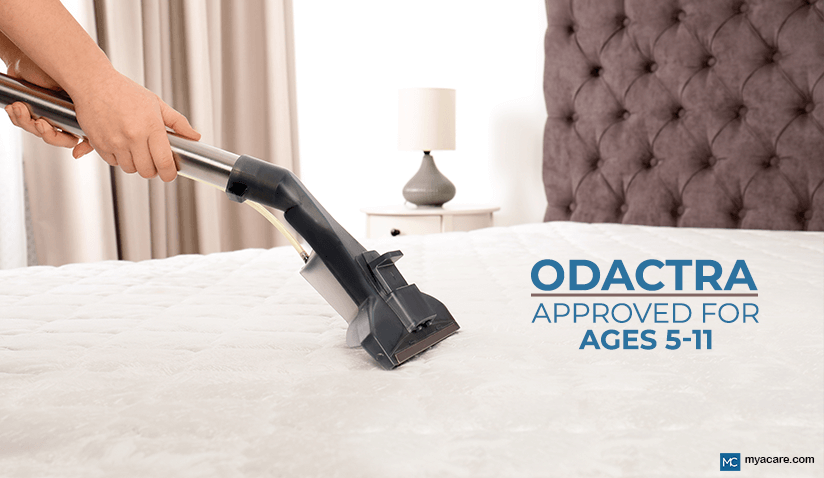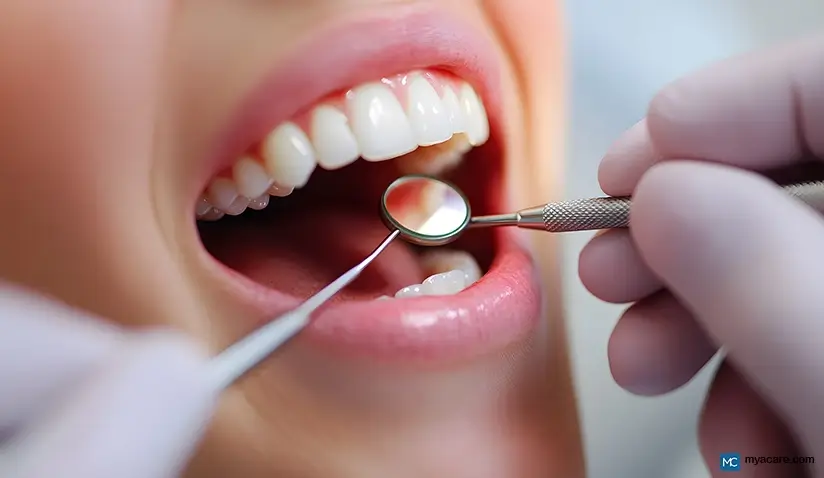Latest Update: Odactra Gains Approval for Pediatric Use

Medically Reviewed by Dr. Sony Sherpa, (MBBS)
House dust mites are among the most common indoor allergens globally. These microscopic arachnids, which feed on dead human skin cells, commonly inhabit bedding, upholstered furniture, carpets, and curtains. For millions of people worldwide, exposure to house dust mites can result in chronic allergic rhinitis and related conditions, such as asthma and conjunctivitis.
In recent years, treatment for dust mite allergy has evolved from symptom relief to targeting the root cause. One such advancement is the introduction of Odactra, a sublingual immunotherapy tablet specifically designed to desensitize the body to dust mite allergens. Odactra offers a convenient and effective option for managing dust mite allergy, and its latest approval in February 2025 for younger children aged 5 through 11 marks a significant step in expanding care.
Understanding House Dust Mite Allergy
House dust mites, scientifically referred to as Dermatophagoides farinae and Dermatophagoides pteronyssinus, flourish in environments with consistent humidity and warmth. They are invisible to the naked eye and cannot bite or sting, but the proteins found in their droppings are potent allergens.
In sensitive individuals, inhaling these allergens triggers the immune system to misidentify them as threats, resulting in the release of inflammatory chemicals like histamine. This cascade results in common allergic symptoms.
Symptoms of House Dust Mite Allergy:
- Persistent sneezing
- Nasal congestion
- Runny nose
- Itchy or watery eyes
- Coughing
- Facial pressure and pain
- Worsening asthma symptoms
These symptoms can affect quality of life, disturb sleep, and contribute to school or work absenteeism.
Latest News: Odactra Approved for Children Aged 5–11
Odactra was first approved in the United States in 2017 for adults aged 18 to 65 for treating house dust mite-induced allergic rhinitis, with or without conjunctivitis. The FDA expanded Odactra's approval in 2023 to include adolescents aged 12 to 17 years.
Recently, in a significant development for younger patients, the FDA approved Odactra for children aged 5 through 11 years in February 2025. This vital move was based on new clinical data that demonstrated both the safety and efficacy of the treatment in younger children.
The study supporting this approval included children with HDM-allergic rhinitis/rhinoconjunctivitis, with or without asthma. Participants who received the tablet showed significant improvement in symptom scores than those who received the placebo. Most adverse events were mild to moderate, mirroring those seen in older individuals.
This expansion aligns with international trends. For example, in Canada and other countries, the therapy is known as ACARIZAX® and has also been approved for use in children.
Significance of This Expansion
This recently approved indication enables families to begin allergy immunotherapy earlier, potentially reducing long-term symptom burden and the need for multiple medications. Introducing allergen-specific treatment at a younger age might influence the natural course of allergic diseases, possibly preventing the development of asthma or more severe allergic conditions later in life.
Early intervention also gives children a better chance at experiencing symptom-free seasons, improved school performance, and better overall quality of life.
Odactra: A Targeted Approach to Immunotherapy
Odactra is the first and only FDA-approved sublingual immunotherapy (SLIT) tablet in the U.S. for house dust mite allergy. It is taken once daily and placed under the tongue, where it dissolves without the need for swallowing or water.
Mechanism of Action
Odactra contains a standardized extract from two primary species of house dust mites: Dermatophagoides farinae and Dermatophagoides pteronyssinus. These extracts work by gradually exposing the immune system to controlled doses of the allergens. Gradually, the immune system becomes less responsive to allergens, resulting in a reduction in both the frequency and severity of symptoms.
Odactra Dosing and Duration:
- Dose: One tablet per day
- Administration: Sublingual (under the tongue), with no food or drink 5 minutes before and after
- Duration: Typically recommended for at least 3 years to achieve long-term benefits
Patients often begin noticing improvement in symptoms within 8–14 weeks, though this can vary.
Benefits of Odactra
- Root Cause Treatment: Unlike antihistamines or decongestants, Odactra targets the underlying cause of the allergy rather than just its symptoms.
- Long-Term Relief: As tolerance develops, patients often report reduced reliance on daily antihistamines or nasal corticosteroids.
- Convenient and Non-Invasive: Oral administration eliminates the need for frequent injections at a clinic, making it suitable for children and those with needle phobia.
- Improved Quality of Life: Effective management of allergy symptoms can lead to better sleep, concentration, and participation in daily activities.
Odactra vs. Other Allergy Treatments
Traditional allergy treatments include:
- Antihistamines and Nasal Corticosteroids: These provide symptomatic relief but do not address the underlying cause of the allergy.
- Allergy Shots (Subcutaneous Immunotherapy): These involve regular injections administered in a clinical setting. While effective, they require frequent visits and may not be practical for children or busy adults.
- Allergy Drops (Off-label Use): Similar to SLIT tablets, but not standardized or FDA-approved in the U.S.
- Environmental Control Measures: To enhance treatment efficacy, it is also recommended to reduce exposure to indoor dust mites. Suggested strategies include:
- Using allergen-proof bedding covers
- Washing sheets in hot water weekly
- Maintaining indoor humidity below 50%
- Vacuuming with HEPA filters
- Removing carpets and heavy curtains where possible
Considerations and Potential Side Effects
Odactra is a prescription medication and should be taken under the guidance of an allergist or immunologist.
Potential Side Effects Include:
- Itching or tingling in the mouth or throat
- Swelling of the lips or tongue (rare)
- Abdominal pain/cramping, nausea, vomiting, or diarrhea
- Watery or itchy eyes
- Shortness of breath
- Tight or swollen throat
- Difficulty swallowing or speaking
- Lightheadedness or fainting
- Rapid or weak heartbeat
- Severe skin flushing or itching
Though side effects are generally mild and transient, more severe allergic reactions, including anaphylaxis, are possible but rare. Medical supervision is necessary, especially during the first few doses.
Contraindications:
- Severe, uncontrolled asthma
- History of eosinophilic esophagitis
- Known hypersensitivity to any component of the tablet
- Use of beta-blockers, as these may interfere with emergency treatment of allergic reactions
Patients should always seek immediate medical care if they encounter signs of a severe allergic reaction, such as trouble breathing or lip swelling.
Odactra is not a cure for dust mite allergy, but it significantly reduces symptoms and the need for other medications over time.
Getting Started with Odactra
- Consult an Allergist or Immunologist: A specialist can evaluate the need for Odactra and explain the benefits and potential risks.
- Allergy Testing: Skin prick testing or specific IgE blood tests confirm house dust mite sensitivity.
- Review Medical History: Discuss any past allergic reactions, asthma control, and concurrent medications.
- Start Therapy: The first dose is typically administered in the doctor’s office under observation for allergic reactions. Subsequent doses are taken daily at home.
- Monitoring: Regular follow-ups help track symptom improvements and manage any side effects.
Conclusion
Odactra represents a major step forward in allergen immunotherapy, offering a precise and patient-friendly approach to managing house dust mite allergy. With the latest approval for children aged 5–11, families now have the opportunity to address the condition earlier and potentially reduce its long-term impact. While not without risks, the treatment provides substantial benefits, especially when combined with environmental control strategies and medical supervision. As awareness grows and more families seek targeted allergy solutions, Odactra may become a cornerstone in the management of dust mite-induced allergic rhinitis across age groups.
FAQ
Can you take Grastek and Odactra at the same time?
It is not generally recommended to take more than one sublingual immunotherapy (SLIT) tablet, such as Grastek (for grass pollen allergy) and Odactra (for dust mite allergy) simultaneously unless specifically advised by your allergist. Combining them may increase the risk of adverse reactions, including oral or systemic allergic responses.
Does Odactra cause weight gain?
No, weight gain is not a reported side effect of Odactra. The medication acts locally under the tongue and does not interfere with metabolism or appetite regulation.
What should I do if I miss a dose?
If you miss a dose, take it promptly unless your next dose is due soon. Never double up. If you have missed several days, consult your doctor before restarting, as a supervised dose may be necessary.
Is Odactra approved for any other conditions?
Currently, Odactra is only FDA-approved for house dust mite-induced allergic rhinitis, with or without conjunctivitis. It is not indicated for asthma or other allergic conditions.
How long does Odactra take to start working?
Some patients begin to notice symptom improvement within 8 to 14 weeks, but full benefits often become more apparent after several months of consistent use. It is typically taken for at least 3 years for long-term efficacy.
Can children safely take Odactra at home?
Yes, after the first dose is given in a healthcare setting under observation, subsequent doses are taken at home once daily. Parents should watch for allergy signs and keep prescribed emergency medication (like epinephrine) readily accessible.
Is allergy testing required before starting Odactra?
Yes, a confirmed diagnosis of house dust mite allergy through skin prick testing or specific IgE blood tests is required before starting treatment to ensure appropriateness and safety.
Can Odactra be taken year-round?
Yes, Odactra is designed to be taken daily year-round since house dust mite exposure is not seasonal but rather persistent throughout the year.
Can my child stop taking other allergy medications after starting Odactra?
Over time, many patients can reduce or stop using antihistamines and nasal sprays. However, changes should only be made under your doctor's guidance based on symptom improvement.
Is there a generic version of Odactra?
No, as of 2025, there is no FDA-approved generic equivalent of Odactra.
To search for the best Pediatric Dermatology doctors and healthcare providers worldwide, please use the Mya Care Search engine.
To search for the best healthcare providers worldwide, please use the Mya Care search engine.
The Mya Care Editorial Team comprises medical doctors and qualified professionals with a background in healthcare, dedicated to delivering trustworthy, evidence-based health content.
Our team draws on authoritative sources, including systematic reviews published in top-tier medical journals, the latest academic and professional books by renowned experts, and official guidelines from authoritative global health organizations. This rigorous process ensures every article reflects current medical standards and is regularly updated to include the latest healthcare insights.

Dr. Sony Sherpa completed her MBBS at Guangzhou Medical University, China. She is a resident doctor, researcher, and medical writer who believes in the importance of accessible, quality healthcare for everyone. Her work in the healthcare field is focused on improving the well-being of individuals and communities, ensuring they receive the necessary care and support for a healthy and fulfilling life.
References:
Featured Blogs



